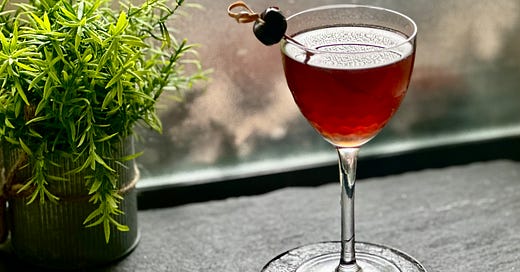The Best Bourbon Manhattans
Three ways to make a bourbon-forward variation on the stirred-and-boozy whiskey classic.
When it comes to Manhattans, I have long considered myself a hardened rye whiskey partisan.
Spicy, peppery, lively rye whiskey is the foundational element of the drink, of the home bar, and of the cocktail renaissance.1 Manhattans should always be made with rye.
Except, that is, when they shouldn’t.
Over the years, with much psychic resistance, I have slowly come to appreciate a well-made bourbon Manhattan. The best versions of the drink cast a different sort of light on the drink — it’s like looking at the same photo, but with a totally different filter. A bourbon Manhattan is sweeter, mellower, cozier, quieter, less formal — but, when made properly, no less delicious.
I want to emphasize “well-made” and “properly,” because most bourbon Manhattans are middling at best, despite, or perhaps because of, the drink’s simplicity. In most iterations, it’s two parts whiskey, one part sweet vermouth, plus a couple dashes of bitters.
But that simplicity means the particular selection of both ingredients is incredibly important. A Manhattan is a partnership between whiskey and vermouth, and the partnering requires a delicate touch. You have to choose the right bourbon and the right sweet vermouth. You have to be alive not only to the specific flavor profiles of each but the ways in which they work together.
Although it is common — and even understandable, given the geographic variances in availability — to see cocktail recipes that call generically for “bourbon” or “sweet vermouth” without specifying particular brands or bottlings, making bourbon Manhattans really drives home the fact that not all bourbons are equal, and not all sweet vermouths taste the same. As with so many cocktails, the bourbon Manhattan presents a casting challenge. Which ingredient will you put in each role?
Often, the casting goes awry. But there are two bourbon Manhattan recipes that I quite enjoy — one fairly conventional, the other a bit of a departure from the usual structure of two parts whiskey to one part vermouth. These two takes on the bourbon Manhattan show off the drink’s almost buttery warmth and gentle sweetness.
Both, however, require somewhat unusual bottles — a difficult-to-find vermouth in one case, a less-than-common bourbon.
This seemed like an opportunity — a gap in the market for an easier-to-execute version of the drink. I wanted to create a bourbon Manhattan that was a little bit more accessible, using widely available, reasonably affordable bourbons and a sweet vermouth I already recommend.
So today we’re going to look at two bourbon Manhattan recipes that helped me appreciate the specific appeal of bourbon versions of the drink.
Then we’ll spend a little bit of time looking at what we can learn from those recipes and the underlying pairing and partnering issues they reveal.
Finally, we’ll make a delicious, cozy, bourbon Manhattan using ingredients that are relatively inexpensive and easy to procure.
The big lesson from all of this? You’re probably not thinking enough about the differences between various brands of sweet vermouth.
Jokes About Bourbon are Inherently…Corny
Typically, as I noted, Manhattans of most any variety follow a very conventional 2:1 (whiskey:vermouth) structure:
Bitters (most often two dashes)
1 ounce sweet vermouth
2 ounces whiskey (bourbon, rye, etc.)
The drink is stirred over ice until well chilled, then served “up” in a coupe or Nick & Nora glass.
The first recipe on today’s docket, however, does not conform to that structure. Even apart from its bourbon base, it is not a traditional Manhattan.
But that’s a big part of what won me over.



